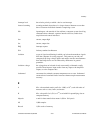
Glossary
©
National Instruments Corporation G-17 AT-MIO-16X User Manual
operating system base-level software that controls a computer, runs programs, interacts
with users, and communicates with installed hardware or peripheral
devices
optical coupler, a device designed to transfer electrical signals by utilizing light waves
optocoupler to provide coupling with electrical isolation between input and output.
Sometimes called optoisolator or photocoupler.
optical isolation the technique of using an optoelectric transmitter and receiver to
transfer data without electrical continuity, to eliminate high-potential
differences and transients
OUT output pin—a counter output pin where the counter can generate
various TTL pulse waveforms
output settling time the amount of time required for the analog output voltage to reach its
final value within specified limits
output slew rate the maximum rate of change of analog output voltage from one level to
another
P
parallel mode a type of SCXI operating mode in which the module sends each of its
input channels directly to a separate analog input channel of the device
to the module
passband the range of frequencies which a device can properly propagate or
measure
pattern generation a type of handshaked (latched) digital I/O in which internal counters
generate the handshaked signal, which in turn initiates a digital transfer.
Because counters output digital pulses at a constant rate, this means you
can generate and retrieve patterns at a constant rate because the
handshaked signal is produced at a constant rate.
PC Card a credit-card-sized expansion card that fits in a PCMCIA slotoften
referred to as a PCMCIA card
PCI Peripheral Component Interconnect—a high-performance expansion
bus architecture originally developed by Intel to replace ISA and EISA.
It is achieving widespread acceptance as a standard for PCs and work-
stations; it offers a theoretical maximum transfer rate of 132 Mbytes/s.


















